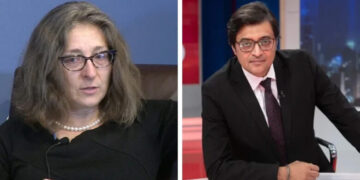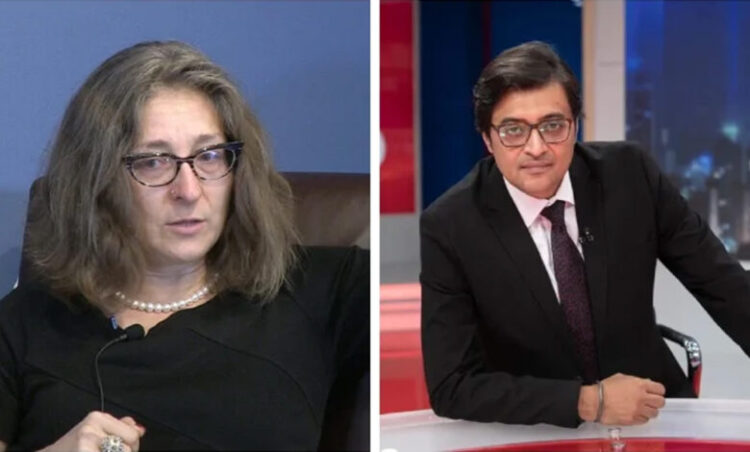In a fiery exchange on his show, prominent Indian news anchor Arnab Goswami engaged in a heated debate with Dr. Christine Fair, an American academic specializing in South Asian security, over accusations that Indian media, including his program, is “jingoistic.” The discussion, which took place on Republic TV’s The Newshour, centered on the media’s response to the 2008 Mumbai terrorist attacks (26/11) and its broader role in shaping public sentiment.
The Context: 26/11 and Media Narratives
The 2008 Mumbai attacks, where 166 people were killed by terrorists linked to Pakistan-based groups, remain a deeply emotional event in India’s collective memory. Goswami, known for his high-decibel debating style, defended the Indian media’s coverage of the attacks, arguing it reflected the public’s anger and grief rather than fueling aggressive nationalism. He referenced his own experience covering the tragedy for “100 hours flat,” emphasizing that tens of thousands gathered at Mumbai’s Gateway of India to support the media’s narrative, which he described as objective rather than jingoistic.
Dr. Fair, however, critiqued the Indian media for amplifying nationalist sentiments, which she argued places undue pressure on politicians to adopt hardline stances. Her perspective, rooted in her academic study of the subcontinent, suggested that such media narratives could complicate India-Pakistan relations.
Goswami’s Rebuttal: A Defense of Indian Sentiment
Goswami strongly rejected Fair’s characterization, calling it “patronizing” and disconnected from the lived experiences of Indians. He argued that labeling the media as jingoistic trivializes the pain felt by a nation that endured repeated terrorist attacks. Drawing a comparison, he questioned whether the U.S. media’s response to 9/11 was similarly labeled as jingoistic, accusing Western academics of applying double standards. “We live in India, unlike you,” Goswami said, underscoring the difference between academic analysis and the ground realities of a country facing terrorism.
He further criticized the Indian government’s response in 2008, noting that then-Foreign Minister Shankar Menon advocated restraint, a stance Goswami implied was inadequate given public outrage. He argued that the media’s role was to echo the people’s demand for action, not to inflame tensions unnecessarily.
Fair’s Perspective and the Clash of Narratives
While Fair’s full argument was not detailed in the exchange, her critique aligns with broader discussions about media responsibility in conflict zones. She suggested that the Indian media’s aggressive tone risks escalating tensions with Pakistan, a point Goswami dismissed as an oversimplification. He accused Fair of “academic intolerance” and operating from an “intellectual ivory tower,” arguing that her lack of lived experience in India undermines her critique.
The debate also touched on global media comparisons, with Goswami alleging that the U.S. media’s post-9/11 coverage, particularly its support for the Iraq War based on the WMD (Weapons of Mass Destruction) narrative, was equally aggressive yet rarely faced similar scrutiny. This highlighted a broader theme of perceived Western hypocrisy in critiquing non-Western media.
Public and Media Reactions
The exchange has sparked varied reactions online. Some viewers praised Goswami for defending India’s perspective, with one user on X calling his rebuttal a “nice takedown” of Western patronization. Others, however, supported Fair’s critique, arguing that Indian media often prioritizes sensationalism over nuance, with one post noting that her argument was “neither fully agreeable nor disagreeable” due to its complexity.
The Bigger Picture: Media’s Role in Shaping National Discourse
This debate underscores ongoing tensions about the role of media in conflict-sensitive regions. Goswami, a polarizing figure known for his unapologetically nationalistic stance, has built a massive following by tapping into public frustration, particularly after events like 26/11. Critics, however, argue that his approach risks inflaming tensions, as seen in past instances where Indian media was accused of irresponsible coverage during the Mumbai attacks, including live broadcasts that endangered operations.
As India continues to navigate complex security challenges, the role of media in balancing public sentiment with responsible reporting remains a contentious issue. The Goswami-Fair exchange highlights the divide between local perspectives and external critiques, raising questions about how media narratives shape national and international perceptions of conflict.
Disclaimer: This article is based on a televised debate and online reactions. Views expressed by individuals do not necessarily reflect those of this publication.
























